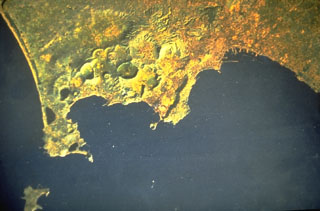Report on Campi Flegrei (Italy) — January 1986
Scientific Event Alert Network Bulletin, vol. 11, no. 1 (January 1986)
Managing Editor: Lindsay McClelland.
Campi Flegrei (Italy) Gradual aseismic subsidence
Please cite this report as:
Global Volcanism Program, 1986. Report on Campi Flegrei (Italy) (McClelland, L., ed.). Scientific Event Alert Network Bulletin, 11:1. Smithsonian Institution. https://doi.org/10.5479/si.GVP.SEAN198601-211010
Campi Flegrei
Italy
40.827°N, 14.139°E; summit elev. 458 m
All times are local (unless otherwise noted)
"Since January 1985, there has been no detectable seismic activity at Campi Flegrei [and] the ground has been subsiding at a mean rate of ~1 cm/month without any seismic activity (figure 15). The pattern of ground deformation during the crisis of 1982-84 was similar to that during 1970-72. The . . . latter crisis was accompanied by moderate seismic activity during the uplift phase. Gas monitoring of fumaroles in Solfatara Crater showed no significant changes in the past year.
"During the past year, people from Pozzuoli have slowly been moving back into the town. The new settlement on the NW side of the caldera has almost been completed, but it is not certain that all of the people evacuated from the town will move in. The fears of an impending eruption are already gone, and the interest of the media has vanished."
Geological Summary. Campi Flegrei is a 13-km-wide caldera that encompasses part of Naples and extends to the south beneath the Gulf of Pozzuoli. Episodes of significant uplift and subsidence within the dominantly trachytic caldera have occurred since Roman times. The earliest known eruptive products are dated 47,000 years BP. The caldera formed following two large explosive eruptions, the massive Campanian ignimbrite about 36,000 BP, and the over 40 km3 Neapolitan Yellow Tuff (NYT) about 15,000 BP. Following eruption of the NYT a large number of eruptions originated from widely scattered subaerial and submarine vents. Most activity occurred during three intervals: 15,000-9,500, 8,600-8,200, and 4,800-3,800 BP. The latest eruption were in 1158 CE at Solfatara and activity in 1538 CE that formed the Monte Nuovo cinder cone.
Information Contacts: G. Luongo and R. Scandone, Osservatorio Vesuviano (OV); F. Barberi, Univ di Pisa.


